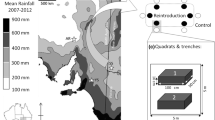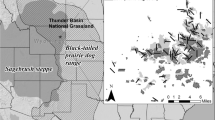Abstract
Legacy effects occur when particular species or their interactions with others have long-lasting impacts, and they are increasingly recognized as important determinants of ecological processes. However, when such legacy effects have been explicitly explored, they most often involve the long-term direct effects of species on systems, as opposed to the indirect effects. Here, we explore how a legacy of small mammal exclusion on the abundance of a shrub, bush lupine (Lupinus arboreus), influences the abundance of a native land snail (Helminthoglypta arrosa) in coastal prairie and dune habitats in central California. The factors that limit populations of land snails are very poorly known despite the threats to the persistence of this group of species. In grasslands, prior vole (Microtus californicus) exclusion created long-lasting gains in bush lupine abundance, mediated through the seedbank, and was associated with increased snail numbers (10×) compared to control plots where mammals were never excluded. Similar plots in dune habitat showed no difference in snail numbers due to previous mammal exclusion. We tested whether increased competition for food, increased predation, and/or lower desiccation explained the decline in snail numbers in plots with reduced lupine cover. Tethering experiments supported the hypothesis that voles can have long-lasting impacts as ecosystem engineers, reducing woody lupine habitat required for successful aestivation by snails. These results add to a growing list of studies that have found that non-trophic interactions can be limiting to invertebrate consumers.



Similar content being viewed by others
References
Aronson RB, Heck KL (1995) Tethering experiments and hypothesis testing in ecology. Mar Ecol Prog Ser 121:307–309
Barbour MG, Craig RB, Drysdale RR, Ghiselin MT (1973) Coastal ecology of Bodega Head. University of California Press, Berkeley
Bastow JL, Preisser EL, Strong DR (2008) Holcus lanatus invasion slows decomposition through its interaction with a macroinvertebrate detritivore, Porcellio scaber. Biol Invasions 10:191–199
Baur B, Baur A (1990) Experimental evidence for intra- and interspecific competition in two species of rock-dwelling land snails. J Anim Ecol 59:301–315
Berger J, Stacey PB, Bellis L, Johnson MP (2001) A mammalian predator-prey imbalance: grizzly and wolf extinction affect avian neotropical migrants. Ecol Appl 11:947–960
Brown JH, Whitham TG, Ernest SKM, Gehring CA (2001) Complex species interactions and the dynamics of ecological systems: long-term experiments. Science 293:643–650
Davidson ED, Barbour MG (1977) Germination, establishment, and demography of coastal bush lupine (Lupinus arboreus) at Bodega Head, California. Ecology 58:592–600
Dunk JR, Zielinski WJ, Preisler HK (2004) Predicting the occurrence of rare mollusks in northern California forests. Ecol Appl 14:713–729
Elton CS (1927) Animal ecology. Macmillan, New York
Foster BA, Stiven AE (1996) Experimental effects of density and food on growth and mortality of the southern Appalachian land gastropod, Mesodon normalis (Pilsbry). Am Midl Nat 136:300–314
Grman E, Suding KN (2010) Within-year soil legacies contribute to strong priority effects of exotics on native California grassland communities. Restor Ecol 18:664–670
Heller J, Dolev A (1994) Biology and population dynamics of a crevice-dwelling landsnail, Cristataria genezarethana (Clausiliidae). J Moll Stud 60:33–46
Huntzinger M, Karban R, Cushman JH (2008) Negative effects of vertebrate herbivores on invertebrates in a coastal dune community. Ecology 89:1972–1980
Jones CG, Lawton JH, Shachak M (1994) Organisms as ecosystem engineers. Oikos 69:373–386
Jones CG, Lawton JH, Shachak M (1997) Positive and negative effects of organisms as physical ecosystem engineers. Ecology 78:1946–1957
Kauffman MJ, Maron JL (2006) Consumers limit the abundance and dynamics of a perennial shrub with a seed bank. Am Nat 168:454–470
Keesing F (1998) Impacts of ungulates on the demography and diversity of small mammals in central Kenya. Oecologia 116:381–389
Kimura K, Chiba S (2010) Interspecific interference competition alters habitat use patterns in two species of land snails. Evol Ecol 24:815–825
Maron JL, Kauffman MJ (2006) Habitat-specific impacts of multiple consumers on plant population dynamics. Ecology 87:113–124
Maron JL, Simms EL (2001) Rodent-limited establishment of bush lupine: field experiments on the cumulative effects of granivory. J Ecol 89:578–588
Milchunas DG, Lauenroth WK (1995) Inertia in plant community structure-state changes after cessation of nutrient-enrichment stress. Ecol Appl 5:452–458
Ohgushi T (2005) Indirect interactions webs: herbivore-induced effects through trait change in plants. Annu Rev Ecol Evol Syst 36:81–105
Pollard E (1975) Aspects of the ecology of Helix pomatia L. J Anim Ecol 44:305–329
Rochette R, Dill LM (2000) Mortality, behavior and the effects of predators on the intertidal distribution of littorinid gastropods. J Exp Mar Biol Ecol 253:165–191
Smit R, Bokdam J, Dn Ouden J, Olff H, Schot-Opschoor H, Schrijvers M (2001) Effects of introduction and exclusion of large herbivores on small rodent communities. Plant Ecol 155:119–127
Speiser B (2001) Food and feeding behaviour. In: Barker GM (ed) The biology of terrestrial molluscs. CABI, Wallingford, pp 259–288
van der Laan KL (1971) The population ecology of the terrestrial snail Helminthoglypta arrosa (Pulmonata: Helicidae). PhD dissertation, University of California, Berkeley
van der Laan KL (1975a) Feeding preferences in a population of the land snail Helminthoglypta arrosa (Binney). Veliger 17:354–359
van der Laan KL (1975b) Aestivation in the land snail, Helminthoglypta arrosa (Binney). Veliger 17:360–368
Acknowledgments
John L. Maron designed, built, and maintained the exclosures. Mikaela Huntzinger designed the experiment; Mikaela Huntzinger and Richard Karban conducted fieldwork. John L. Maron, Mikaela Huntzinger, and Richard Karban collaborated to evaluate results. Richard Karban and Mikaela Huntzinger wrote the manuscript.
Author information
Authors and Affiliations
Corresponding author
Additional information
Communicated by Matthias Schaefer.
Rights and permissions
About this article
Cite this article
Huntzinger, M., Karban, R. & Maron, J.L. Small mammals cause non-trophic effects on habitat and associated snails in a native system. Oecologia 167, 1085–1091 (2011). https://doi.org/10.1007/s00442-011-2054-5
Received:
Accepted:
Published:
Issue Date:
DOI: https://doi.org/10.1007/s00442-011-2054-5




